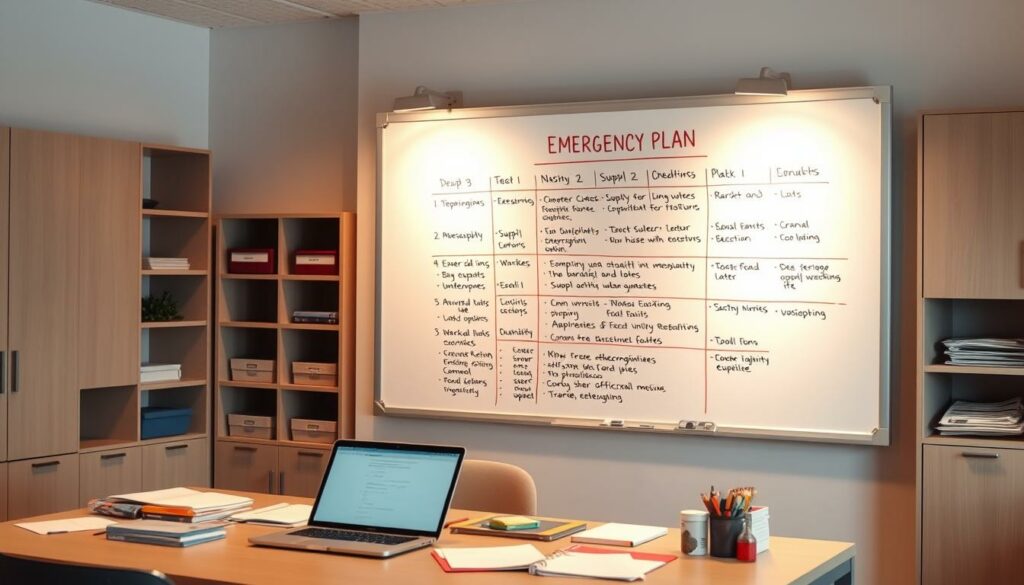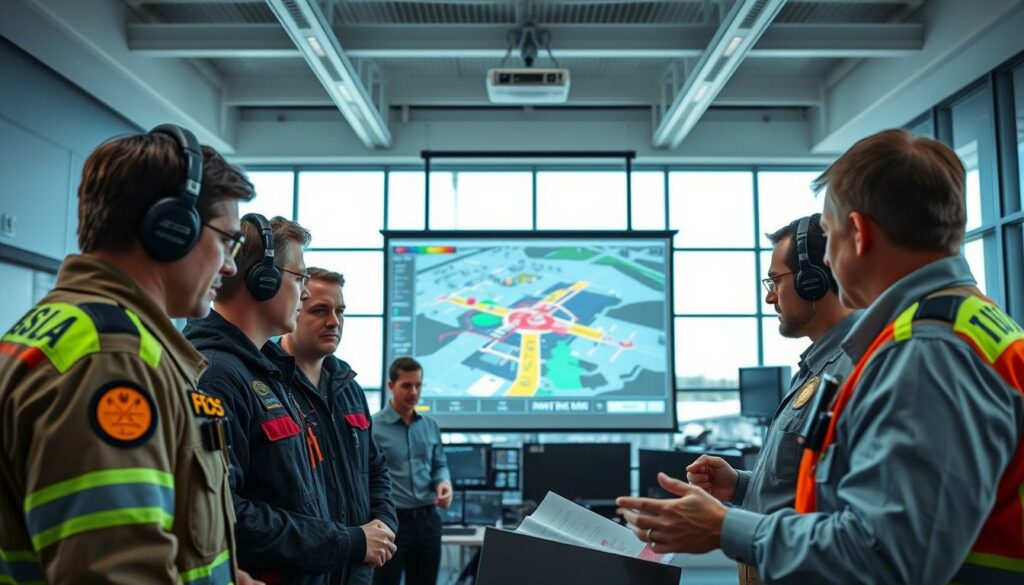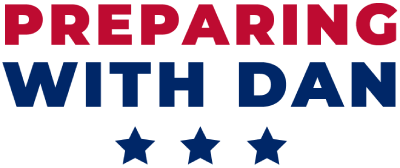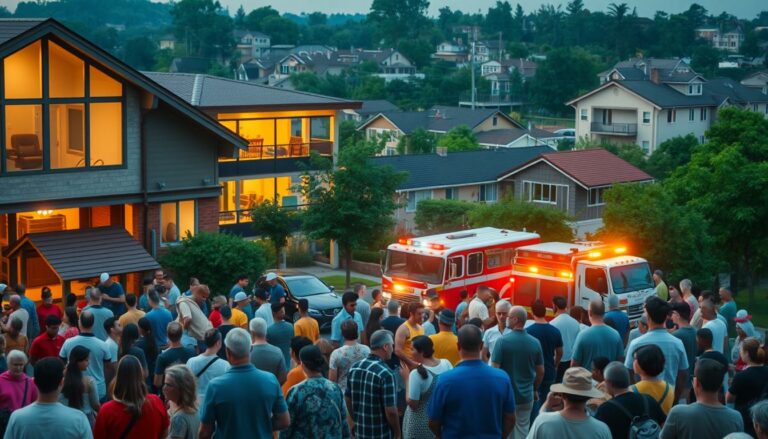Nuclear emergency drills are key to keeping communities safe during nuclear disasters. They teach people how to act during such events, lowering the risk of radiation harm. By joining in these drills, communities can keep their health safe from dangers like Acute Radiation Syndrome (ARS) and thyroid cancer from radioactive iodine.
The Food and Drug Administration (FDA) has approved medical countermeasures to help people survive after radiation exposure. Potassium Iodide (KI) is very important. It stops radioactive iodine from getting into the thyroid gland, a key action in nuclear emergencies. How well these efforts work depends on everyone in the community working together.
The success of these drills relies on everyone knowing and doing their part. Getting residents and local leaders involved makes a community strong and ready to act fast in emergencies. With good planning, clear communication, and training, communities can lessen the harm from radiation and stay safer.
Key Takeaways
- Nuclear emergency drills are essential for community safety and preparedness.
- FDA-approved Potassium Iodide (KI) helps block radioactive iodine absorption.
- Effective community response reduces the risks of Acute Radiation Syndrome (ARS).
- Understanding and participation from all community members are critical.
- Engaging local leaders fosters a resilient and informed community.
Understanding Nuclear Drills
Nuclear drills are exercises that mimic nuclear incidents to check if a community is ready. They involve many groups like emergency teams, hospitals, and government. The main goal is to keep everyone safe and prepared.
What Are Nuclear Drills?
Nuclear drills cover scenarios like accidental leaks or sabotage. They test how fast and well communities can respond. The Nuclear Regulatory Commission makes sure all nuclear plants do these drills every two years.
These drills check how ready communities are for radiation leaks up to 10 miles away. They also test how well people can stay safe up to 50 miles away.
Importance of Nuclear Preparedness
Nuclear safety is very important. In the U.S., there have been no injuries or deaths from radiation. Even big accidents, like Three Mile Island, didn’t hurt anyone’s health.
Drills are key to being ready. The NRC checks these drills to make sure they meet standards. Plans are updated to handle new threats and emergencies.
During emergencies, people are moved away from danger. Staying inside can help keep you safe from radiation.
Potassium Iodide (KI) is also important. It helps protect the thyroid from radioactive iodine. The FDA says it’s safe and effective.
There are plans to help people affected by nuclear incidents. Drills test these plans and teach communities how to respond quickly and well.
| Key Statistic | Information |
|---|---|
| Zero physical injuries | No public radiation injuries in U.S. nuclear power plant history |
| Three Mile Island impact | No identifiable health impacts from the worst U.S. nuclear accident |
| NRC drill mandate | Biennial emergency planning exercises required for all plants |
| Evacuation zones | Minimum two-mile radius, five-mile downwind in a General Emergency |
| Potassium Iodide (KI) | FDA-approved, prevents thyroid absorption of radioactive iodine |
Types of Nuclear Drills
Preparing for nuclear emergencies requires different drills to get everyone ready. These drills teach people how to protect themselves and their families. The main drills are evacuation procedures, shelter-in-place, and emergency communication.
Evacuation Drills
Evacuation drills teach people how to leave dangerous areas quickly and safely. They learn about the best routes and where to meet up. It’s also about making fast decisions when it matters most.
Shelter-in-Place Drills
Shelter-in-place drills show how to stay safe at home during a nuclear event. They highlight the use of potassium iodide (KI) to protect the thyroid. It’s key to take KI within 24 hours before or 4 hours after exposure.
| Age Group | Recommended KI Dosage | Equivalent Oral Solution |
|---|---|---|
| Infants (Birth – 1 Month) | 16 mg | 0.25 mL |
| Children (1 Month – 3 Years) | 32 mg | 0.5 mL |
| Children (3 – 12 Years) | 65 mg | 1 mL or 1/2 130 mg tablet |
| Adolescents (12 – 18 Years) | 65 mg | 1 mL or 1/2 130 mg tablet |
| Adults (18 – 40 Years) | 130 mg | 2 mL or 1 whole 130 mg tablet |
| Pregnant/Lactating Women | 130 mg | 2 mL or 1 whole 130 mg tablet |
Communication Drills
Good emergency communication is vital during a nuclear crisis. These drills teach leaders and members how to share important info fast. This helps clear up confusion and keeps everyone informed quickly.
Building a Culture of Safety
To build a strong safety culture, we need to work together. This means focusing on community engagement and getting local leaders involved. We should aim to make sure everyone is ready and knows how to act in emergencies.
Engaging the Community
Getting the community involved is key to a strong safety culture. By holding workshops and town meetings, we can teach people about being ready for nuclear emergencies. Experts can share important info on how to evacuate and the use of potassium iodide (KI) tablets to lower radiation risks.
- Workshops on nuclear preparedness
- Town meetings facilitated by emergency experts
- Distribution of educational materials on the use of KI tablets
When people get involved, they feel a sense of responsibility and trust. This is vital for a good emergency response. It not only raises awareness but also helps people protect themselves and their families.
Involving Local Leaders
Getting local leaders on board is also very important. Leadership in emergencies is not just about titles. It’s about anyone who can help and inspire others. Mayors, school principals, and business owners are key in making sure safety rules are followed.
Leaders who know what they’re doing make a big difference. They show the importance of safety and guide people on what to do. This kind of leadership helps create a culture of safety and teamwork, essential for getting through tough times.
Working together, local leaders and emergency teams can achieve great things. Their partnership helps make sure community efforts fit into the bigger emergency plan.
| Key Strategy | Benefit |
|---|---|
| Community Workshops | Enhance Awareness and Preparedness |
| Town Meetings | Increased Public Participation |
| Local Leader Involvement | Stronger Leadership in Emergencies |
Developing a Comprehensive Plan
When facing nuclear emergencies, communities must create strong disaster plans. They need to address weaknesses and set up clear emergency steps. This helps protect people and ensures a quick response. By looking at each community’s unique risks, officials can make their plans work best.

Assessing Vulnerabilities
It’s important to do a detailed risk assessment to find weak spots in the community. Knowing which areas might be hit by a nuclear incident helps officials focus their efforts. For example, the FDA says it’s key to protect kids, pregnant women, and others at high risk from radiation.
By making emergency plans for these groups, we can lower health risks. This is a big step in keeping everyone safe.
Establishing Clear Protocols
After finding vulnerabilities, it’s vital to set up clear emergency plans. These plans should outline who does what and how to communicate. It’s also important to have clear channels for sharing important information fast.
For example, knowing how much potassium iodide (KI) to give to different age groups is critical. This info helps prevent serious health problems. By using advice from trusted sources like the FDA, communities can make plans that really work.
Training First Responders
Effective first responder training is key for those facing nuclear emergencies. Specialized training programs and emergency simulations make sure our teams are ready. They help build the skills needed for crisis situations.
Specialized Training Programs
These programs give first responders the right knowledge and skills. They include:
- Seven hours of continuing education for Florida-licensed radiologic technologists.
- 7.0 contact hours for individuals certified under section 381.0101, FS.
- Continuing education approval provided by the Florida Department of Health, Office of Public Health Nursing.
- Continuing education credits for EMTs and paramedics, contingent upon medical director signature.
The Florida Medical Reserve Corps (MRC) and the Florida Department of Health, Bureau of Radiation Control (BRC) sponsor these sessions. They focus on medical professionals like doctors, EMTs, and nurses. They combine the skills of MRC volunteers and RRVC volunteers.
Simulation Exercises
Training includes emergency simulations that mimic real crises. These exercises help first responders practice working together. They learn how to respond quickly and effectively in a nuclear crisis.
- Managing radiation exposure incidents.
- Strategic use of Potassium Iodide (KI).
- Decontamination techniques, including those used for animals.
“Simulation exercises prepare first responders by mirroring real crises, leading to improved readiness and efficiency during actual emergencies.”
These emergency simulations are vital for improving response times in nuclear crises.
| Year | Event |
|---|---|
| 1979 | Recommendation to stockpile KI for emergency workers. |
| 1980 | NRC/FEMA guides recommend KI availability for emergency workers. |
| 1999 | Strategic National Stockpile (SNS) program initiated. |
| 2000 | SNS acquires 130 mg KI tablets. |
| 2001 | NRC updates regulations to include KI as a protective measure. |
| 2002 | Public Health Security Act establishes HHS support for KI distribution. |
| 2005 | HHS acquires KI for SNS. |
| 2014 | PHEMCE reintroduces modest quantities of KI. |
Informing the Public
It’s key to educate communities about nuclear emergencies. We need to share important info through campaigns and media. This way, everyone knows what to do in a crisis.
Educational Campaigns
Campaigns are vital for teaching nuclear safety. They tell us about Potassium Iodide (KI) and its role in safety. Kids are at high risk for thyroid cancer from radiation, like after Chernobyl.
So, it’s important to teach the right KI doses for each age. This helps protect everyone from radiation harm.
| Age Group | Recommended KI Dosage |
|---|---|
| Adults over 18 years | 130 mg |
| 12-18 years over 150 pounds | 130 mg |
| 12-18 years under 150 pounds | 65 mg |
| 3-12 years | 65 mg |
| 1 month to 3 years | 32 mg |
| Birth to 1 month | 16 mg |
By sharing these facts, we can help people use KI right. This lowers the risk of thyroid cancer and other diseases from radiation.
Utilizing Media Resources
Media is a strong tool for sharing emergency info fast and right. It lets authorities reach more people. With ads, social media, and local news, info gets out quickly.
For example, media can tell people where to get KI. In places like New Jersey, KI is given to those near nuclear plants.
Good media work also fights false info. This makes communities better prepared for nuclear threats. With the right education and media, we can all be safer.
Collaborating with Local Organizations
Building strong community partnerships is key to being ready for nuclear emergencies. Working with schools and nonprofits helps make our communities stronger and more prepared.
Partnering with Schools
Using school safety programs is a smart move. Schools can share important emergency info and practice drills. This way, students learn vital skills early.
Also, schools near nuclear plants get free potassium iodide (KI) tablets. This helps protect all students in these areas.
Working with Nonprofits
Team up with nonprofit collaboration to boost emergency readiness. Nonprofits have the tools and networks to spread out supplies and train communities. For instance, Pennsylvania gave out free KI tablets on August 22, 2024, to those near nuclear plants.
Nonprofits help by distributing these resources and spreading the word. This makes sure everyone, including those who are most vulnerable, knows how to handle nuclear emergencies.
Evaluating Drill Effectiveness
It’s key to check how well nuclear emergency drills work to keep communities ready. By getting feedback and looking at how well drills did, groups can see what’s good and what needs work.
Gathering Feedback
Getting feedback is key to making drill plans better. At Idaho National Laboratory (INL) on October 21, 2014, a big drill showed how important feedback is. The drill, which was a big test, showed how to get better.
Everyone involved, like emergency teams and government agencies, gave their thoughts. This helped make future drills better and more effective.

Analyzing Performance Metrics
Measuring how well drills did is very important. Drills are tested over many years with different scenarios. For example, at the INL drill, most goals were met, but some needed work.
Looking closely at how drills did helps achieve goals. This includes quick responses, emergency team activation, and clear communication. This way, drills keep getting better, making communities safer.
| Exercise Duration | Specific Requirements |
|---|---|
| Biennial (every 2 years) |
|
| 8-Year Cycle |
|
Implementing Technology in Drills
Modern technology has changed how we prepare for emergencies. Using apps and virtual reality, we can get better at responding to threats. This makes our drills more effective.
Using Apps for Coordination
Coordination apps help us communicate quickly and efficiently. They let emergency teams share information fast. This makes drills more realistic and helps everyone practice together.
Apps like these offer big benefits:
- They keep everyone updated in real-time.
- They help manage resources better.
- They track data and analytics.
Simulating Scenarios with Virtual Reality
Virtual reality puts responders in real emergency situations safely. It makes training more effective and memorable.
These virtual reality simulations are great for training. They offer a safe space to practice and find areas for improvement. The main advantages are:
- They make training feel more real.
- They help spot weaknesses in plans.
- They let us practice often without extra cost.
| Technology | Key Benefits |
|---|---|
| Coordination Apps | Real-time updates, efficient resource allocation, data tracking |
| Virtual Reality Simulations | Realistic training, gap identification, cost-effective practice |
Using emergency technology in drills makes us better prepared. Apps and virtual reality help us respond quickly and well to threats.
Scheduling Regular Drills
Regular drills are key to keeping communities ready for emergencies. By planning and running drills all year, we make sure our responses are sharp. This follows Section 50.47(b), with 16 standards for emergency plans at nuclear sites.
Annual Drill Planning
It’s important to practice every year. This way, everyone knows what to do in a nuclear emergency. The rules say we must cover different scenarios in our drills.
Drills each year help us find and fix any weak spots in our plans. Feedback from the public, like the 65 letters in 1995, helps make our plans better. The Commission’s decision in 1997 to fund KI stockpiles shows our dedication to safety.
Addressing Seasonal Considerations
Drills must account for the challenges of each season. Extreme weather can make it hard to respond quickly. Drills in different seasons help us stay ready.
The proposed rule in 1999 got 77 comments, including from a U.S. Senator. It shows how important it is to adjust our plans for the seasons. Drills that take these changes into account are critical for our safety.
“Evacuation and sheltering are considered the most effective means of public protection during a radiological emergency.”
Comprehensive Examination
| Aspect | Details |
|---|---|
| Protective Actions | Range of actions for EPZ |
| K.I. Stockpiling | State and regional funding |
| Community Feedback | Comments and revisions |
| Seasonal Drills | Impact of weather conditions |
Encouraging Personal Preparedness
Being ready for emergencies starts at home. It’s about personal safety and having the right supplies.
Tips for Home Readiness
Preparing your home for emergencies is key. Start by making home emergency kits. These kits should have water, non-perishable food, first-aid supplies, and medications.
Potassium iodide (KI) tablets are important for protecting the thyroid from radioactive iodine. Data shows 58% of people have KI tablets. And 95% know where they are about 2.5 years later. This is a big part of personal safety.
Creating Family Emergency Plans
Having a detailed family safety plan is also vital. This plan should cover different scenarios, like evacuation routes and how to stay in touch.
But, 52% of people don’t know their evacuation route. And 27% don’t know where to find this info. So, it’s important to teach family members about these things.
Make sure the plan includes where to meet, how to stay in touch, and what to do in emergencies. Review and practice the plan often. This makes sure everyone stays calm and safe during emergencies.
Good planning and home emergency kits make a big difference. They help families respond quickly and safely to emergencies. This keeps everyone safe and sound.
Looking to the Future
The world of emergency preparedness is changing fast. New ways to deal with nuclear emergencies are coming up. We’re seeing more use of technology and stronger community bonds.
This change keeps safety and sustainability top priorities. It’s all about getting ready for the future.
Trends in Emergency Preparedness
Advanced tech like AI and VR is becoming key in emergency prep. AI helps make quick, smart choices during crises. VR lets first responders train in safe, real-like scenarios.
Mobile apps are also getting more use. They help share info fast during drills. This makes sure everyone gets the news they need right away.
The Role of Community Resilience
Building strong communities is key to lasting preparedness. It’s about working together to face and get over disasters. Working with local groups, like schools and charities, is vital.
Teaching families how to be ready helps make homes safer. This way, communities can handle nuclear threats better. It’s all about being ready and working together for safety.
FAQ
What Are Nuclear Emergency Drills?
Nuclear emergency drills are simulations to prepare communities for nuclear incidents. They test readiness and emergency response plans.
Why Is Nuclear Preparedness Important?
Nuclear preparedness is key to reduce risks in a disaster. Drills and strategies help protect lives and property.
What Is an Evacuation Drill?
Evacuation drills teach quick and safe exit during a nuclear emergency. They show the best routes and procedures.
What Are Shelter-in-Place Drills?
Shelter-in-place drills teach staying safe at home during a nuclear incident. They include using Potassium Iodide to protect against radiation.
How Do Communication Drills Work?
Communication drills ensure critical info is shared during a nuclear emergency. They help reduce chaos and misinformation.
How Can the Community Be Engaged in Safety Drills?
Engage the community through workshops and town meetings. This education ensures everyone knows their role in emergencies.
Why Is Involving Local Leaders Important in Nuclear Drills?
Local leaders inspire trust and ensure compliance with safety protocols. Their involvement improves coordination and support.
How Are Community Vulnerabilities Assessed?
Vulnerabilities are identified to improve emergency response plans. This helps enhance overall preparedness.
What Are Clear Protocols in an Emergency Response Plan?
Clear protocols provide specific guidelines for emergencies. They detail roles and responsibilities, improving response efficiency.
What Specialized Training Programs Are Available for First Responders?
Specialized training programs prepare first responders for nuclear emergencies. They equip responders with necessary skills.
How Do Simulation Exercises Help First Responders?
Simulation exercises provide realistic training for first responders. They enhance preparedness and ability to manage emergencies.
What Are Educational Campaigns About Nuclear Safety?
Educational campaigns inform the public about nuclear safety. They ensure accurate information reaches everyone, improving safety.
How Can Media Resources Be Utilized for Public Information?
Media resources are key for sharing nuclear safety information. They help spread updates and instructions quickly.
How Do Schools Contribute to Nuclear Emergency Preparedness?
Schools teach safety drills and emergency readiness. They ensure students and staff know how to respond in emergencies.
How Can Nonprofits Aid in Emergency Preparedness?
Nonprofits help with resource distribution and training. They ensure essential supplies and info are available during emergencies.
Why Is Gathering Feedback on Drills Important?
Feedback helps identify drill strengths and areas for improvement. It’s vital for refining emergency plans.
How Are Performance Metrics Used to Evaluate Drills?
Performance metrics provide data on drill success. Analyzing this data improves emergency readiness.
How Can Apps Enhance Coordination During Emergencies?
Apps facilitate communication and info sharing during emergencies. They improve response efficiency.
What Role Does Virtual Reality Play in Training?
Virtual reality simulations offer realistic training scenarios. They help participants practice responses in a controlled environment.
How Often Should Nuclear Drills Be Scheduled?
Drills should be scheduled at least annually. Regular practice keeps the community prepared.
Why Are Seasonal Considerations Important in Drill Planning?
Seasonal variations affect emergency response. Considering these in drill planning ensures effective strategies.
What Are Some Tips for Home Readiness?
Prepare an emergency kit with essential items like Potassium Iodide. Create a family emergency plan and stay informed. These steps prepare individuals and families for emergencies.
How Should Families Create Emergency Plans?
Families should create detailed emergency plans. Include evacuation routes, communication strategies, and emergency supply locations.
What Trends Are Emerging in Emergency Preparedness?
Trends include using technology and building resilient communities. These aim to improve emergency response efficiency.
How Can Communities Build Resilience?
Communities can build resilience through preparedness, engagement, and collaboration. Continuous education and drills ensure effective emergency response.
Source Links
- https://www.fda.gov/emergency-preparedness-and-response/mcm-issues/radiological-and-nuclear-emergency-preparedness
- https://www.cnsc-ccsn.gc.ca/eng/resources/emergency-management-and-safety/
- https://www.nrc.gov/reading-rm/doc-collections/fact-sheets/emerg-plan-prep-nuc-power.html
- https://www.cdc.gov/radiation-emergencies/hcp/nuclear-detonations/evaluation-and-management.html
- https://www.cdc.gov/radiation-emergencies/treatment/potassium-iodide.html
- https://remm.hhs.gov/potassiumiodide.htm
- https://www.nrc.gov/about-nrc/emerg-preparedness/about-emerg-preparedness/potassium-iodide/ki-faq.html
- https://www.jointcommission.org/-/media/tjc/documents/resources/patient-safety-topics/work-place-violence-prevention/updated-wsps-monograph-final-42020.pdf
- https://www.health.ny.gov/environmental/radiological/potassium_iodide/information_for_the_public.htm
- https://www.fda.gov/drugs/bioterrorism-and-drug-preparedness/frequently-asked-questions-potassium-iodide-ki
- https://www.floridahealth.gov/environmental-health/radiation-control/envrad/rrvc-course-reg.html
- https://remm.hhs.gov/KIdistribution.htm
- https://news.clemson.edu/first-responders-train-to-help-the-helpless-in-a-radiological-emergency/
- https://www.health.ny.gov/environmental/radiological/potassium_iodide/docs/information_for_the_public.pdf
- https://www.nj.gov/health/er/documents/ki_faq.pdf
- https://www.pa.gov/agencies/health/newsroom/department-of-health-distributes-free-ki-tablets-to-pennsylvania.html
- https://www.ams.usda.gov/sites/default/files/media/2024TechnicalReportPotassiumIodideHandling.pdf
- https://fanr.gov.ae/en/Documents/FANR-RG-034 Preparation Conduct and Evaluation of Drills and Exercises Version 0.pdf
- https://inldigitallibrary.inl.gov/sites/sti/sti/6339791.pdf
- https://news.ontariotechu.ca/archives/2020/01/why-potassium-iodide-pills-are-not-the-only-consideration-for-nuclear-radiation-protection.php
- https://edu.rsc.org/experiments/electrolysis-of-potassium-iodide-solution/738.article
- https://www.federalregister.gov/documents/2001/01/19/01-1156/consideration-of-potassium-iodide-in-emergency-plans
- https://www.calverthealth.org/healththreats/healthhazards/pi_usage.htm
- https://pmc.ncbi.nlm.nih.gov/articles/PMC1854974/
- https://www.yorkcountygov.com/FAQ.aspx?QID=111
- https://www.mayoclinic.org/drugs-supplements/iodine-and-potassium-iodide-strong-iodine-oral-route/description/drg-20062037
- https://www.prnewswire.com/news-releases/worldwide-potassium-iodide-industry-to-2030—-escalating-demand-for-solid-potassium-iodide-presents-opportunities-301508872.html
- https://www.databridgemarketresearch.com/reports/global-potassium-iodide-market?srsltid=AfmBOooEOtRmwagpbpPKB5opNoP9cGfcvvaubfhZSF39pahCxrg4acdu

